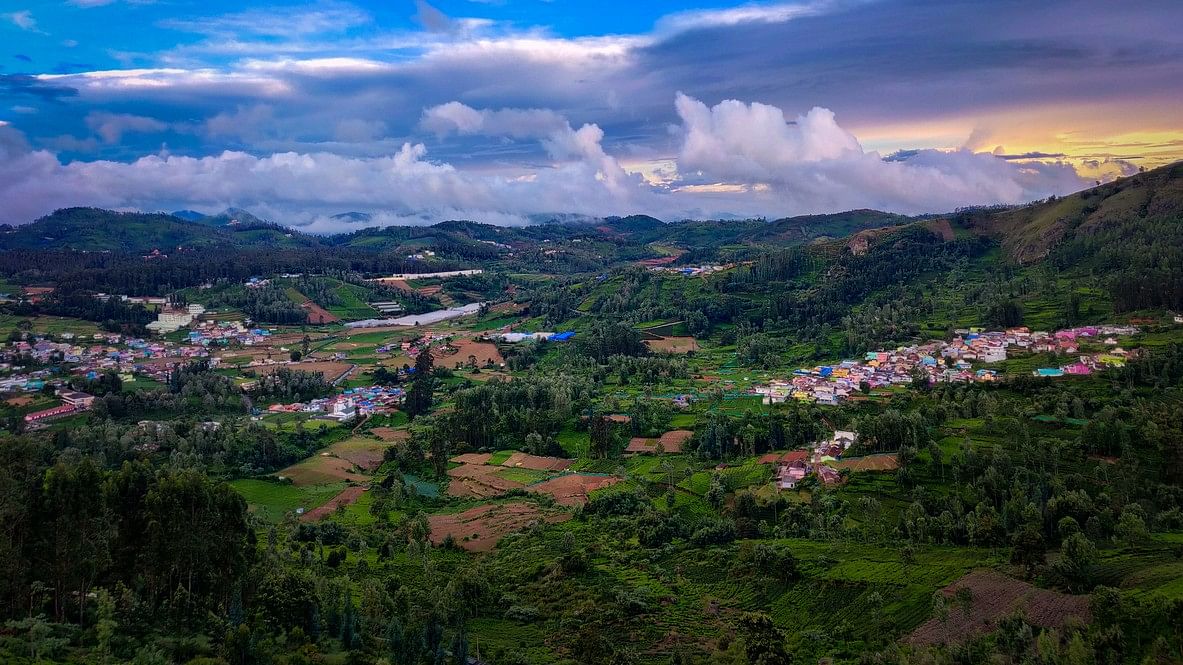
Nilgiri Hills.
Credit: iStock Photo
Chennai: The devastating landslide in Wayanad that claimed the lives of over 200 people has environmentalists and activists in Tamil Nadu worried over the ecologically sensitive areas in Western Ghats, especially the picturesque Nilgiris, whose topography is similar to that of the current disaster zone in Kerala.
The experts say the governments should “wake up” at least now and take “remedial measures” to prevent a repeat of the Wayanad episode in Nilgiris, an ecologically fragile area where concrete structures – especially luxury bungalows -- continue to mushroom each passing day despite restrictions.
Preserving the remaining shola forests and grasslands, increasing the shola forests wherever possible, restricting new construction, restricting the number of tourists, and abandoning new hydro-tidal power projects in the Nilgiris are some of the immediate steps that the state government should start with, experts said.
If urgent measures aren’t taken, Nilgiris cannot help but stare at such a tragedy since the topography in the hill station and Wayanad are similar with thick layers of soil going down up to 100 feet to 200 feet, the experts added.
Valparai in Coimbatore district and some parts of the Nilgiris have been affected by landslides in the past few weeks, claiming the lives of about half a dozen people.
“The primary focus should be to ensure that the soil is tight and it doesn’t go loose at any cost. To make this happen, we have to protect the shola forests and grasslands in the entire Nilgiris. We should ensure there is no further degradation of the soil,” said Dr B Ramakrishnan, Head, Department of Wildlife Biology, Government Arts College, Ooty.
He told DH that removal of invasive species like wattle, Lantana camara, Cestrum, and gorse, and other exotic species like eucalyptus must be removed from the areas, while stress should be laid on planting native Shola species wherever it is possible.
Another expert who didn’t wish to be named pushed for the imposition of strict regulation on the construction of new concrete structures in the Nilgiris. “The government should find out the carrying capacity of the ecologically sensitive areas and ensure that it isn’t exceeded,” the expert added.
Nilgiris has been grappling with the effects of climate change for the past few years with the famous hill station recording near-zero temperatures with a nail-biting cold in January and experiencing the highest ever temperature in April at 29 degrees Celsius. Kothagiri and Coonoor in Nilgiris received about 37 cm each of rainfall in just a day in 2023, with high-intensity rains becoming the order of the day.
Prabhakaran Veeraarasu, environmental engineer, Poovulagin Nanbargal an NGO, told DH that the state government should set up a Landslide Research Centre in the Nilgiris to monitor landslides and shift the famous Flower Show from Ooty that attracts over a million people in just about a month to Mettupalayam or Pollachi.
“The government should immediately abandon hydro-tidal power projects that are in the pipeline. These are quite big in capacity (1,200 MW) and they have the potential to change the nature of the water flow since tunnels are formed by breaking the hills. These are fragile areas and they shouldn’t be disturbed,” Veeraarasu said.
He also advocated for the regulation of tourists into hill stations like Ooty which is crowded between April and June as lakhs of people flock to beat the summer heat.
“We need to regulate tourism in these places. The Flower Show was conceived three decades ago to popularise Ooty. Since the town is unable to handle tourists, the show should be shifted to Mettupalayam or Pollachi. Ooty’s tourist burden should be reduced,” he said, advocating setting up landslide monitoring scales at risk points as an early warning system.
The Nilgiri Documentation Centre (NDC) has urged the Chief Ministers of Tamil Nadu, Karnataka, and Kerala to have a joint discussion on the issue of mountain conservation in the Western Ghats, contending that only coordinated efforts would help the cause.